Creative Enterprise and Innovation Report: Strategy and Culture
VerifiedAdded on 2023/06/10
|13
|3802
|286
Report
AI Summary
This report delves into the critical aspects of creative enterprise and innovation, emphasizing the importance of sustainable and innovative strategies within organizations to adapt to the ever-changing business environment. It explores the significance of a healthy organizational culture and the skills needed to foster it. The report uses Unilever, a British multinational consumer goods company, as a case study, analyzing its operations and strategies in light of the challenges posed by the COVID-19 pandemic. It examines sustainable creative strategies, innovation strategies, and their interrelation, highlighting the role of technology and the importance of environmental considerations. Furthermore, the report discusses organizational culture, the skills required to execute it, and the role of leadership, transparency, and diversity in creating a positive and productive workplace. The report concludes with recommendations for Unilever to expand its business post-pandemic, providing a comprehensive overview of the subject matter.
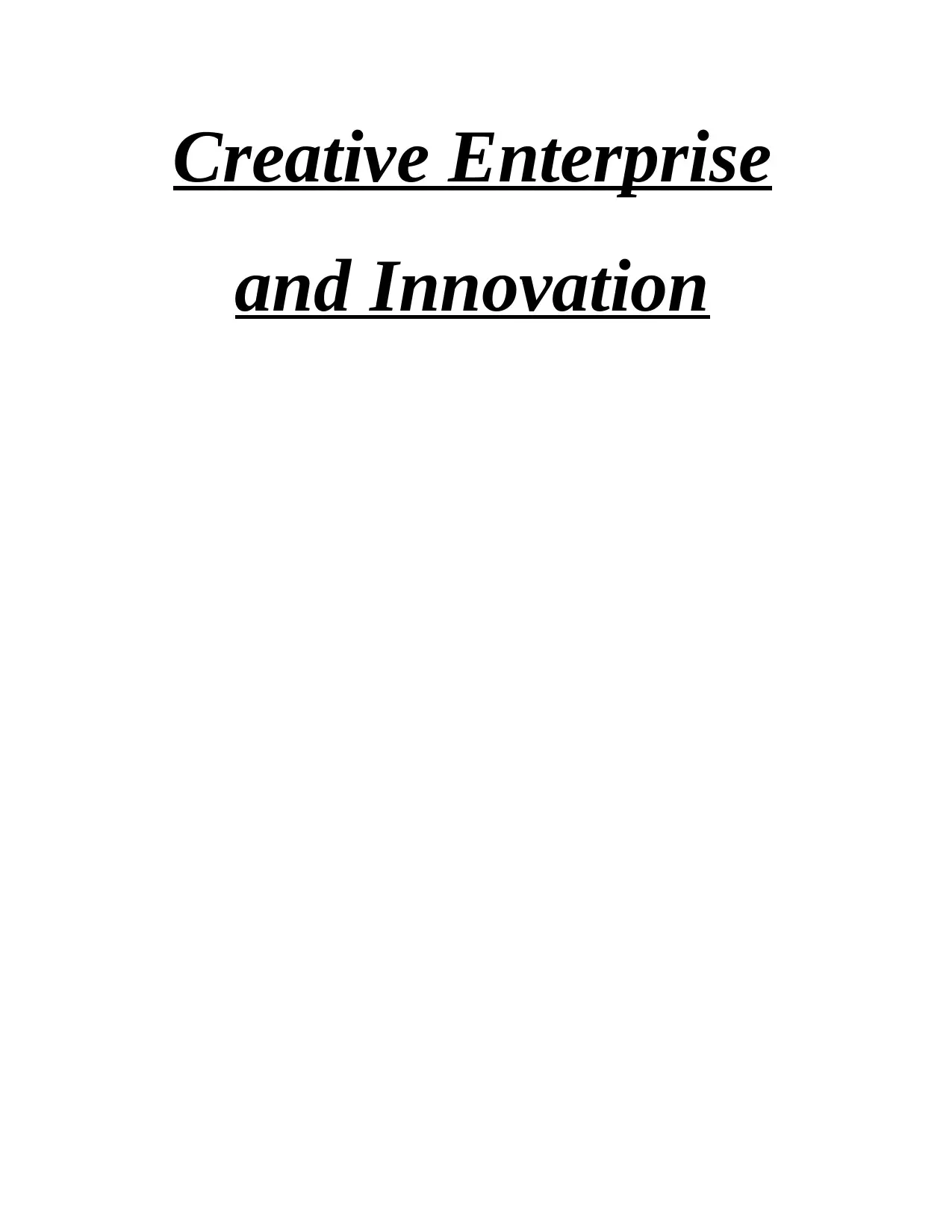
Creative Enterprise
and Innovation
and Innovation
Paraphrase This Document
Need a fresh take? Get an instant paraphrase of this document with our AI Paraphraser

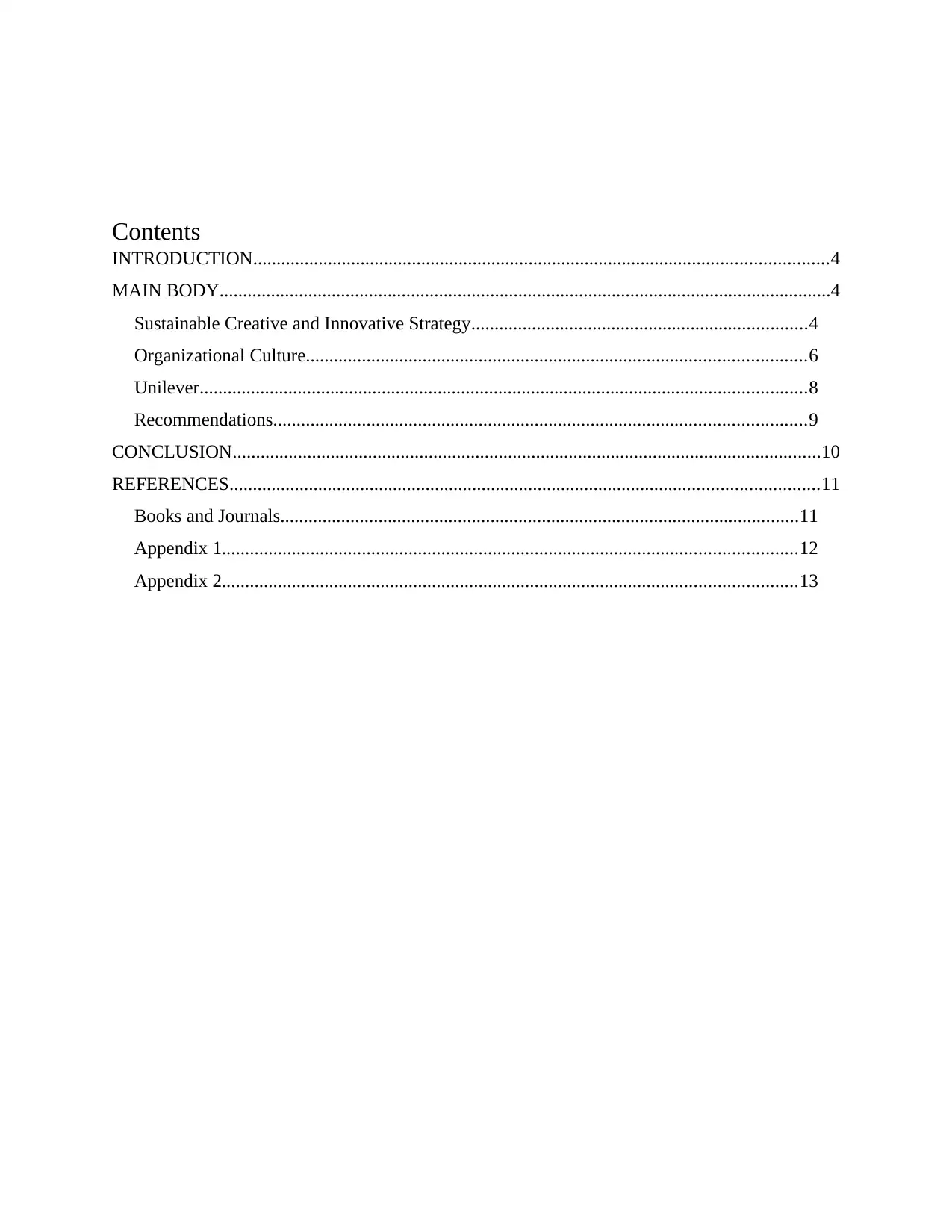
Contents
INTRODUCTION...........................................................................................................................4
MAIN BODY...................................................................................................................................4
Sustainable Creative and Innovative Strategy........................................................................4
Organizational Culture...........................................................................................................6
Unilever..................................................................................................................................8
Recommendations..................................................................................................................9
CONCLUSION..............................................................................................................................10
REFERENCES..............................................................................................................................11
Books and Journals...............................................................................................................11
Appendix 1...........................................................................................................................12
Appendix 2...........................................................................................................................13
INTRODUCTION...........................................................................................................................4
MAIN BODY...................................................................................................................................4
Sustainable Creative and Innovative Strategy........................................................................4
Organizational Culture...........................................................................................................6
Unilever..................................................................................................................................8
Recommendations..................................................................................................................9
CONCLUSION..............................................................................................................................10
REFERENCES..............................................................................................................................11
Books and Journals...............................................................................................................11
Appendix 1...........................................................................................................................12
Appendix 2...........................................................................................................................13
⊘ This is a preview!⊘
Do you want full access?
Subscribe today to unlock all pages.

Trusted by 1+ million students worldwide
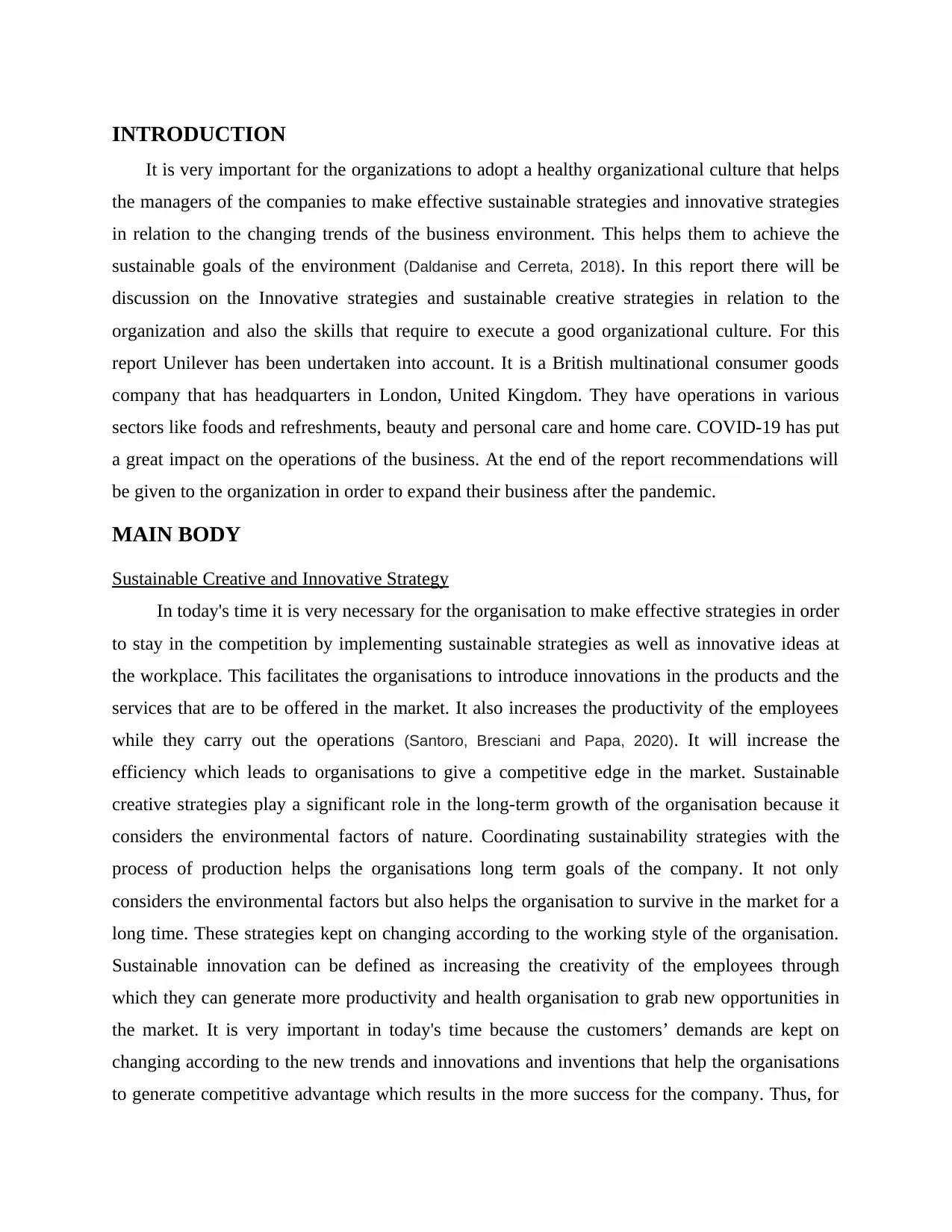
INTRODUCTION
It is very important for the organizations to adopt a healthy organizational culture that helps
the managers of the companies to make effective sustainable strategies and innovative strategies
in relation to the changing trends of the business environment. This helps them to achieve the
sustainable goals of the environment (Daldanise and Cerreta, 2018). In this report there will be
discussion on the Innovative strategies and sustainable creative strategies in relation to the
organization and also the skills that require to execute a good organizational culture. For this
report Unilever has been undertaken into account. It is a British multinational consumer goods
company that has headquarters in London, United Kingdom. They have operations in various
sectors like foods and refreshments, beauty and personal care and home care. COVID-19 has put
a great impact on the operations of the business. At the end of the report recommendations will
be given to the organization in order to expand their business after the pandemic.
MAIN BODY
Sustainable Creative and Innovative Strategy
In today's time it is very necessary for the organisation to make effective strategies in order
to stay in the competition by implementing sustainable strategies as well as innovative ideas at
the workplace. This facilitates the organisations to introduce innovations in the products and the
services that are to be offered in the market. It also increases the productivity of the employees
while they carry out the operations (Santoro, Bresciani and Papa, 2020). It will increase the
efficiency which leads to organisations to give a competitive edge in the market. Sustainable
creative strategies play a significant role in the long-term growth of the organisation because it
considers the environmental factors of nature. Coordinating sustainability strategies with the
process of production helps the organisations long term goals of the company. It not only
considers the environmental factors but also helps the organisation to survive in the market for a
long time. These strategies kept on changing according to the working style of the organisation.
Sustainable innovation can be defined as increasing the creativity of the employees through
which they can generate more productivity and health organisation to grab new opportunities in
the market. It is very important in today's time because the customers’ demands are kept on
changing according to the new trends and innovations and inventions that help the organisations
to generate competitive advantage which results in the more success for the company. Thus, for
It is very important for the organizations to adopt a healthy organizational culture that helps
the managers of the companies to make effective sustainable strategies and innovative strategies
in relation to the changing trends of the business environment. This helps them to achieve the
sustainable goals of the environment (Daldanise and Cerreta, 2018). In this report there will be
discussion on the Innovative strategies and sustainable creative strategies in relation to the
organization and also the skills that require to execute a good organizational culture. For this
report Unilever has been undertaken into account. It is a British multinational consumer goods
company that has headquarters in London, United Kingdom. They have operations in various
sectors like foods and refreshments, beauty and personal care and home care. COVID-19 has put
a great impact on the operations of the business. At the end of the report recommendations will
be given to the organization in order to expand their business after the pandemic.
MAIN BODY
Sustainable Creative and Innovative Strategy
In today's time it is very necessary for the organisation to make effective strategies in order
to stay in the competition by implementing sustainable strategies as well as innovative ideas at
the workplace. This facilitates the organisations to introduce innovations in the products and the
services that are to be offered in the market. It also increases the productivity of the employees
while they carry out the operations (Santoro, Bresciani and Papa, 2020). It will increase the
efficiency which leads to organisations to give a competitive edge in the market. Sustainable
creative strategies play a significant role in the long-term growth of the organisation because it
considers the environmental factors of nature. Coordinating sustainability strategies with the
process of production helps the organisations long term goals of the company. It not only
considers the environmental factors but also helps the organisation to survive in the market for a
long time. These strategies kept on changing according to the working style of the organisation.
Sustainable innovation can be defined as increasing the creativity of the employees through
which they can generate more productivity and health organisation to grab new opportunities in
the market. It is very important in today's time because the customers’ demands are kept on
changing according to the new trends and innovations and inventions that help the organisations
to generate competitive advantage which results in the more success for the company. Thus, for
Paraphrase This Document
Need a fresh take? Get an instant paraphrase of this document with our AI Paraphraser
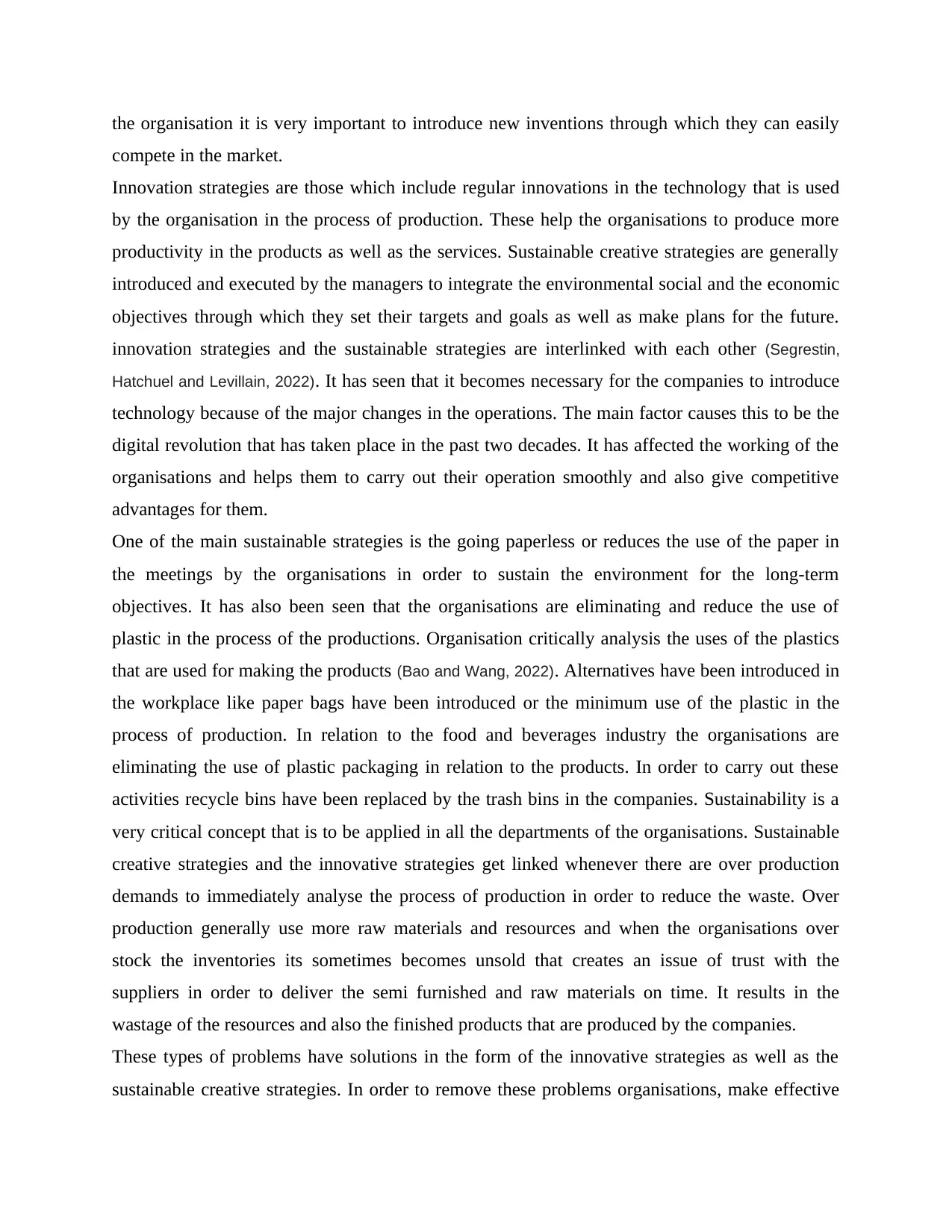
the organisation it is very important to introduce new inventions through which they can easily
compete in the market.
Innovation strategies are those which include regular innovations in the technology that is used
by the organisation in the process of production. These help the organisations to produce more
productivity in the products as well as the services. Sustainable creative strategies are generally
introduced and executed by the managers to integrate the environmental social and the economic
objectives through which they set their targets and goals as well as make plans for the future.
innovation strategies and the sustainable strategies are interlinked with each other (Segrestin,
Hatchuel and Levillain, 2022). It has seen that it becomes necessary for the companies to introduce
technology because of the major changes in the operations. The main factor causes this to be the
digital revolution that has taken place in the past two decades. It has affected the working of the
organisations and helps them to carry out their operation smoothly and also give competitive
advantages for them.
One of the main sustainable strategies is the going paperless or reduces the use of the paper in
the meetings by the organisations in order to sustain the environment for the long-term
objectives. It has also been seen that the organisations are eliminating and reduce the use of
plastic in the process of the productions. Organisation critically analysis the uses of the plastics
that are used for making the products (Bao and Wang, 2022). Alternatives have been introduced in
the workplace like paper bags have been introduced or the minimum use of the plastic in the
process of production. In relation to the food and beverages industry the organisations are
eliminating the use of plastic packaging in relation to the products. In order to carry out these
activities recycle bins have been replaced by the trash bins in the companies. Sustainability is a
very critical concept that is to be applied in all the departments of the organisations. Sustainable
creative strategies and the innovative strategies get linked whenever there are over production
demands to immediately analyse the process of production in order to reduce the waste. Over
production generally use more raw materials and resources and when the organisations over
stock the inventories its sometimes becomes unsold that creates an issue of trust with the
suppliers in order to deliver the semi furnished and raw materials on time. It results in the
wastage of the resources and also the finished products that are produced by the companies.
These types of problems have solutions in the form of the innovative strategies as well as the
sustainable creative strategies. In order to remove these problems organisations, make effective
compete in the market.
Innovation strategies are those which include regular innovations in the technology that is used
by the organisation in the process of production. These help the organisations to produce more
productivity in the products as well as the services. Sustainable creative strategies are generally
introduced and executed by the managers to integrate the environmental social and the economic
objectives through which they set their targets and goals as well as make plans for the future.
innovation strategies and the sustainable strategies are interlinked with each other (Segrestin,
Hatchuel and Levillain, 2022). It has seen that it becomes necessary for the companies to introduce
technology because of the major changes in the operations. The main factor causes this to be the
digital revolution that has taken place in the past two decades. It has affected the working of the
organisations and helps them to carry out their operation smoothly and also give competitive
advantages for them.
One of the main sustainable strategies is the going paperless or reduces the use of the paper in
the meetings by the organisations in order to sustain the environment for the long-term
objectives. It has also been seen that the organisations are eliminating and reduce the use of
plastic in the process of the productions. Organisation critically analysis the uses of the plastics
that are used for making the products (Bao and Wang, 2022). Alternatives have been introduced in
the workplace like paper bags have been introduced or the minimum use of the plastic in the
process of production. In relation to the food and beverages industry the organisations are
eliminating the use of plastic packaging in relation to the products. In order to carry out these
activities recycle bins have been replaced by the trash bins in the companies. Sustainability is a
very critical concept that is to be applied in all the departments of the organisations. Sustainable
creative strategies and the innovative strategies get linked whenever there are over production
demands to immediately analyse the process of production in order to reduce the waste. Over
production generally use more raw materials and resources and when the organisations over
stock the inventories its sometimes becomes unsold that creates an issue of trust with the
suppliers in order to deliver the semi furnished and raw materials on time. It results in the
wastage of the resources and also the finished products that are produced by the companies.
These types of problems have solutions in the form of the innovative strategies as well as the
sustainable creative strategies. In order to remove these problems organisations, make effective
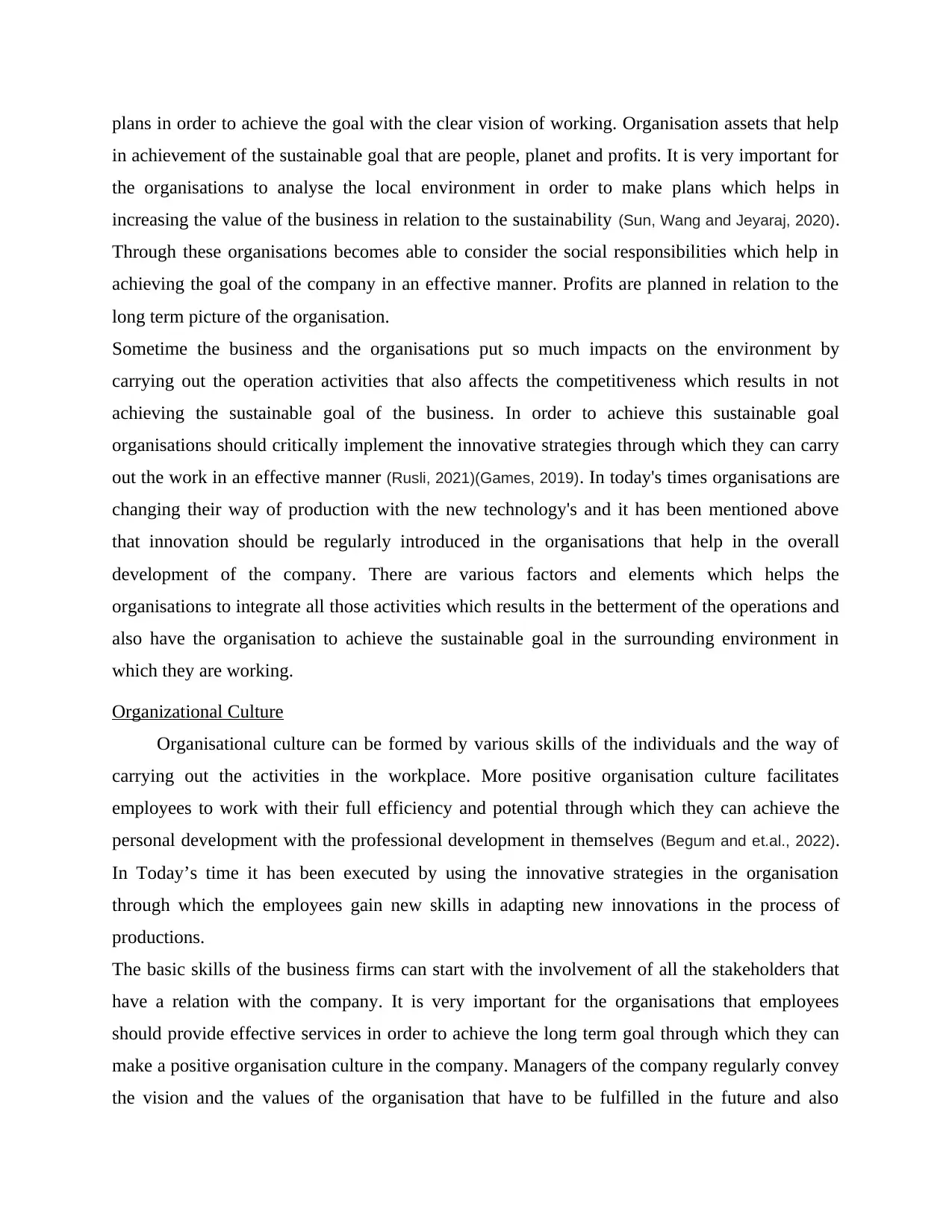
plans in order to achieve the goal with the clear vision of working. Organisation assets that help
in achievement of the sustainable goal that are people, planet and profits. It is very important for
the organisations to analyse the local environment in order to make plans which helps in
increasing the value of the business in relation to the sustainability (Sun, Wang and Jeyaraj, 2020).
Through these organisations becomes able to consider the social responsibilities which help in
achieving the goal of the company in an effective manner. Profits are planned in relation to the
long term picture of the organisation.
Sometime the business and the organisations put so much impacts on the environment by
carrying out the operation activities that also affects the competitiveness which results in not
achieving the sustainable goal of the business. In order to achieve this sustainable goal
organisations should critically implement the innovative strategies through which they can carry
out the work in an effective manner (Rusli, 2021)(Games, 2019). In today's times organisations are
changing their way of production with the new technology's and it has been mentioned above
that innovation should be regularly introduced in the organisations that help in the overall
development of the company. There are various factors and elements which helps the
organisations to integrate all those activities which results in the betterment of the operations and
also have the organisation to achieve the sustainable goal in the surrounding environment in
which they are working.
Organizational Culture
Organisational culture can be formed by various skills of the individuals and the way of
carrying out the activities in the workplace. More positive organisation culture facilitates
employees to work with their full efficiency and potential through which they can achieve the
personal development with the professional development in themselves (Begum and et.al., 2022).
In Today’s time it has been executed by using the innovative strategies in the organisation
through which the employees gain new skills in adapting new innovations in the process of
productions.
The basic skills of the business firms can start with the involvement of all the stakeholders that
have a relation with the company. It is very important for the organisations that employees
should provide effective services in order to achieve the long term goal through which they can
make a positive organisation culture in the company. Managers of the company regularly convey
the vision and the values of the organisation that have to be fulfilled in the future and also
in achievement of the sustainable goal that are people, planet and profits. It is very important for
the organisations to analyse the local environment in order to make plans which helps in
increasing the value of the business in relation to the sustainability (Sun, Wang and Jeyaraj, 2020).
Through these organisations becomes able to consider the social responsibilities which help in
achieving the goal of the company in an effective manner. Profits are planned in relation to the
long term picture of the organisation.
Sometime the business and the organisations put so much impacts on the environment by
carrying out the operation activities that also affects the competitiveness which results in not
achieving the sustainable goal of the business. In order to achieve this sustainable goal
organisations should critically implement the innovative strategies through which they can carry
out the work in an effective manner (Rusli, 2021)(Games, 2019). In today's times organisations are
changing their way of production with the new technology's and it has been mentioned above
that innovation should be regularly introduced in the organisations that help in the overall
development of the company. There are various factors and elements which helps the
organisations to integrate all those activities which results in the betterment of the operations and
also have the organisation to achieve the sustainable goal in the surrounding environment in
which they are working.
Organizational Culture
Organisational culture can be formed by various skills of the individuals and the way of
carrying out the activities in the workplace. More positive organisation culture facilitates
employees to work with their full efficiency and potential through which they can achieve the
personal development with the professional development in themselves (Begum and et.al., 2022).
In Today’s time it has been executed by using the innovative strategies in the organisation
through which the employees gain new skills in adapting new innovations in the process of
productions.
The basic skills of the business firms can start with the involvement of all the stakeholders that
have a relation with the company. It is very important for the organisations that employees
should provide effective services in order to achieve the long term goal through which they can
make a positive organisation culture in the company. Managers of the company regularly convey
the vision and the values of the organisation that have to be fulfilled in the future and also
⊘ This is a preview!⊘
Do you want full access?
Subscribe today to unlock all pages.

Trusted by 1+ million students worldwide
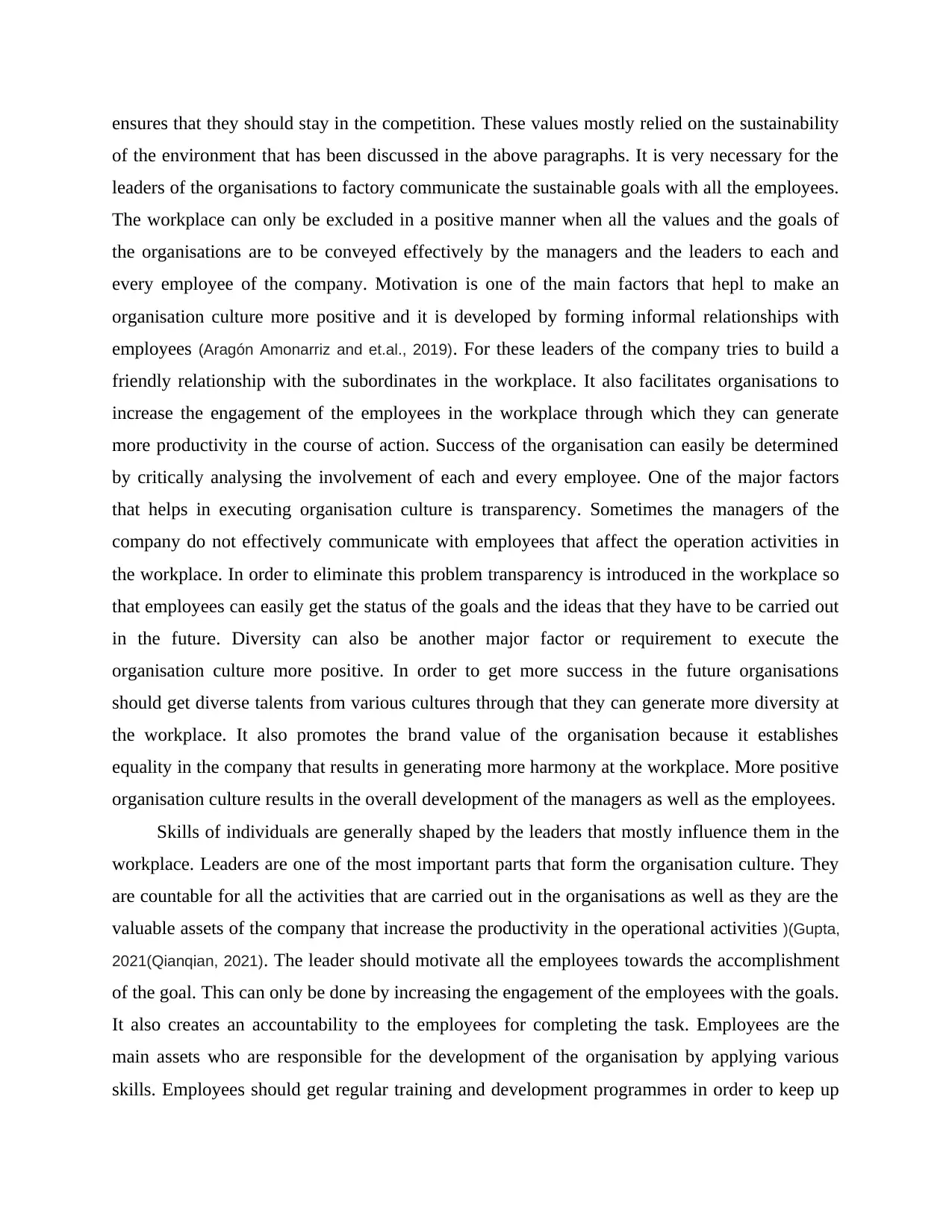
ensures that they should stay in the competition. These values mostly relied on the sustainability
of the environment that has been discussed in the above paragraphs. It is very necessary for the
leaders of the organisations to factory communicate the sustainable goals with all the employees.
The workplace can only be excluded in a positive manner when all the values and the goals of
the organisations are to be conveyed effectively by the managers and the leaders to each and
every employee of the company. Motivation is one of the main factors that hepl to make an
organisation culture more positive and it is developed by forming informal relationships with
employees (Aragón Amonarriz and et.al., 2019). For these leaders of the company tries to build a
friendly relationship with the subordinates in the workplace. It also facilitates organisations to
increase the engagement of the employees in the workplace through which they can generate
more productivity in the course of action. Success of the organisation can easily be determined
by critically analysing the involvement of each and every employee. One of the major factors
that helps in executing organisation culture is transparency. Sometimes the managers of the
company do not effectively communicate with employees that affect the operation activities in
the workplace. In order to eliminate this problem transparency is introduced in the workplace so
that employees can easily get the status of the goals and the ideas that they have to be carried out
in the future. Diversity can also be another major factor or requirement to execute the
organisation culture more positive. In order to get more success in the future organisations
should get diverse talents from various cultures through that they can generate more diversity at
the workplace. It also promotes the brand value of the organisation because it establishes
equality in the company that results in generating more harmony at the workplace. More positive
organisation culture results in the overall development of the managers as well as the employees.
Skills of individuals are generally shaped by the leaders that mostly influence them in the
workplace. Leaders are one of the most important parts that form the organisation culture. They
are countable for all the activities that are carried out in the organisations as well as they are the
valuable assets of the company that increase the productivity in the operational activities )(Gupta,
2021(Qianqian, 2021). The leader should motivate all the employees towards the accomplishment
of the goal. This can only be done by increasing the engagement of the employees with the goals.
It also creates an accountability to the employees for completing the task. Employees are the
main assets who are responsible for the development of the organisation by applying various
skills. Employees should get regular training and development programmes in order to keep up
of the environment that has been discussed in the above paragraphs. It is very necessary for the
leaders of the organisations to factory communicate the sustainable goals with all the employees.
The workplace can only be excluded in a positive manner when all the values and the goals of
the organisations are to be conveyed effectively by the managers and the leaders to each and
every employee of the company. Motivation is one of the main factors that hepl to make an
organisation culture more positive and it is developed by forming informal relationships with
employees (Aragón Amonarriz and et.al., 2019). For these leaders of the company tries to build a
friendly relationship with the subordinates in the workplace. It also facilitates organisations to
increase the engagement of the employees in the workplace through which they can generate
more productivity in the course of action. Success of the organisation can easily be determined
by critically analysing the involvement of each and every employee. One of the major factors
that helps in executing organisation culture is transparency. Sometimes the managers of the
company do not effectively communicate with employees that affect the operation activities in
the workplace. In order to eliminate this problem transparency is introduced in the workplace so
that employees can easily get the status of the goals and the ideas that they have to be carried out
in the future. Diversity can also be another major factor or requirement to execute the
organisation culture more positive. In order to get more success in the future organisations
should get diverse talents from various cultures through that they can generate more diversity at
the workplace. It also promotes the brand value of the organisation because it establishes
equality in the company that results in generating more harmony at the workplace. More positive
organisation culture results in the overall development of the managers as well as the employees.
Skills of individuals are generally shaped by the leaders that mostly influence them in the
workplace. Leaders are one of the most important parts that form the organisation culture. They
are countable for all the activities that are carried out in the organisations as well as they are the
valuable assets of the company that increase the productivity in the operational activities )(Gupta,
2021(Qianqian, 2021). The leader should motivate all the employees towards the accomplishment
of the goal. This can only be done by increasing the engagement of the employees with the goals.
It also creates an accountability to the employees for completing the task. Employees are the
main assets who are responsible for the development of the organisation by applying various
skills. Employees should get regular training and development programmes in order to keep up
Paraphrase This Document
Need a fresh take? Get an instant paraphrase of this document with our AI Paraphraser
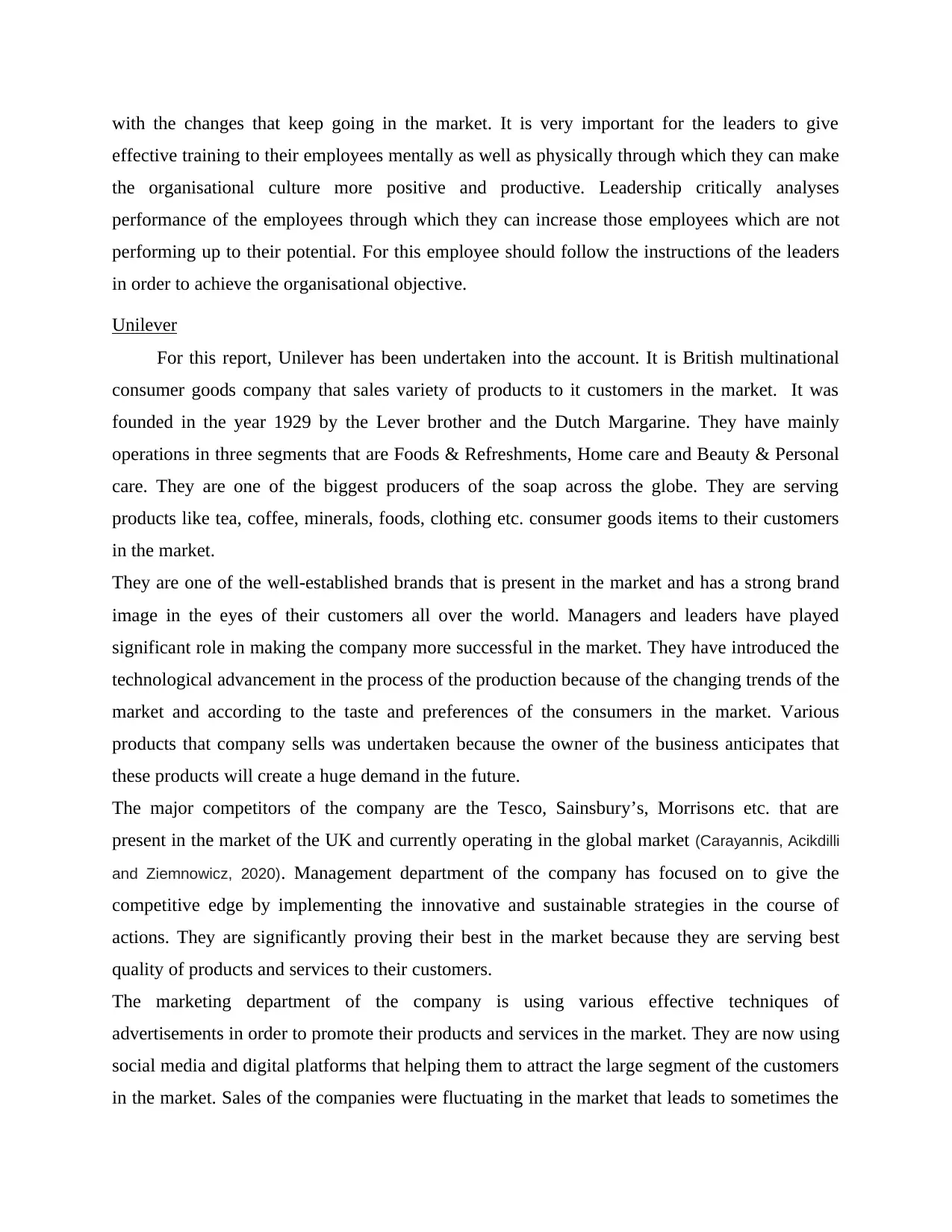
with the changes that keep going in the market. It is very important for the leaders to give
effective training to their employees mentally as well as physically through which they can make
the organisational culture more positive and productive. Leadership critically analyses
performance of the employees through which they can increase those employees which are not
performing up to their potential. For this employee should follow the instructions of the leaders
in order to achieve the organisational objective.
Unilever
For this report, Unilever has been undertaken into the account. It is British multinational
consumer goods company that sales variety of products to it customers in the market. It was
founded in the year 1929 by the Lever brother and the Dutch Margarine. They have mainly
operations in three segments that are Foods & Refreshments, Home care and Beauty & Personal
care. They are one of the biggest producers of the soap across the globe. They are serving
products like tea, coffee, minerals, foods, clothing etc. consumer goods items to their customers
in the market.
They are one of the well-established brands that is present in the market and has a strong brand
image in the eyes of their customers all over the world. Managers and leaders have played
significant role in making the company more successful in the market. They have introduced the
technological advancement in the process of the production because of the changing trends of the
market and according to the taste and preferences of the consumers in the market. Various
products that company sells was undertaken because the owner of the business anticipates that
these products will create a huge demand in the future.
The major competitors of the company are the Tesco, Sainsbury’s, Morrisons etc. that are
present in the market of the UK and currently operating in the global market (Carayannis, Acikdilli
and Ziemnowicz, 2020). Management department of the company has focused on to give the
competitive edge by implementing the innovative and sustainable strategies in the course of
actions. They are significantly proving their best in the market because they are serving best
quality of products and services to their customers.
The marketing department of the company is using various effective techniques of
advertisements in order to promote their products and services in the market. They are now using
social media and digital platforms that helping them to attract the large segment of the customers
in the market. Sales of the companies were fluctuating in the market that leads to sometimes the
effective training to their employees mentally as well as physically through which they can make
the organisational culture more positive and productive. Leadership critically analyses
performance of the employees through which they can increase those employees which are not
performing up to their potential. For this employee should follow the instructions of the leaders
in order to achieve the organisational objective.
Unilever
For this report, Unilever has been undertaken into the account. It is British multinational
consumer goods company that sales variety of products to it customers in the market. It was
founded in the year 1929 by the Lever brother and the Dutch Margarine. They have mainly
operations in three segments that are Foods & Refreshments, Home care and Beauty & Personal
care. They are one of the biggest producers of the soap across the globe. They are serving
products like tea, coffee, minerals, foods, clothing etc. consumer goods items to their customers
in the market.
They are one of the well-established brands that is present in the market and has a strong brand
image in the eyes of their customers all over the world. Managers and leaders have played
significant role in making the company more successful in the market. They have introduced the
technological advancement in the process of the production because of the changing trends of the
market and according to the taste and preferences of the consumers in the market. Various
products that company sells was undertaken because the owner of the business anticipates that
these products will create a huge demand in the future.
The major competitors of the company are the Tesco, Sainsbury’s, Morrisons etc. that are
present in the market of the UK and currently operating in the global market (Carayannis, Acikdilli
and Ziemnowicz, 2020). Management department of the company has focused on to give the
competitive edge by implementing the innovative and sustainable strategies in the course of
actions. They are significantly proving their best in the market because they are serving best
quality of products and services to their customers.
The marketing department of the company is using various effective techniques of
advertisements in order to promote their products and services in the market. They are now using
social media and digital platforms that helping them to attract the large segment of the customers
in the market. Sales of the companies were fluctuating in the market that leads to sometimes the
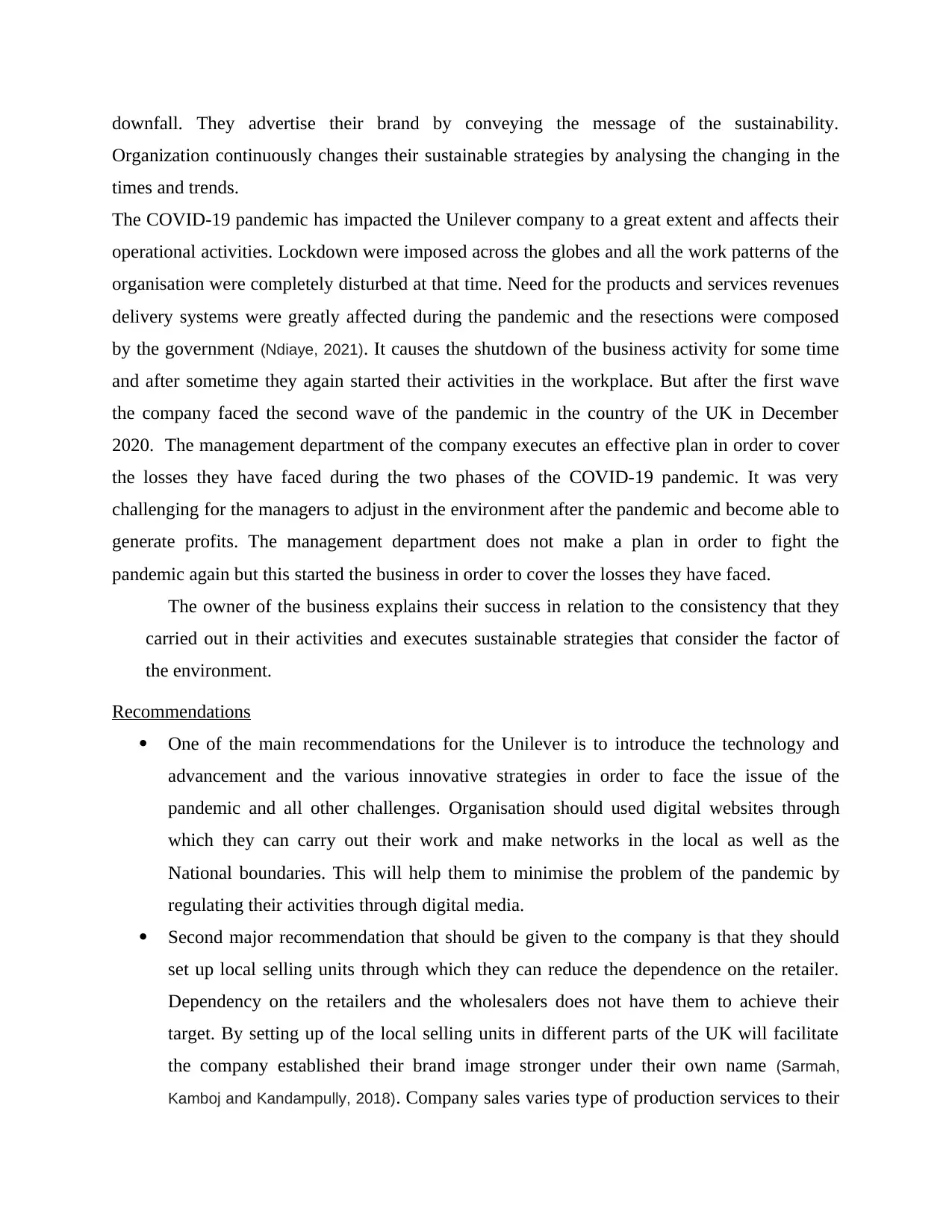
downfall. They advertise their brand by conveying the message of the sustainability.
Organization continuously changes their sustainable strategies by analysing the changing in the
times and trends.
The COVID-19 pandemic has impacted the Unilever company to a great extent and affects their
operational activities. Lockdown were imposed across the globes and all the work patterns of the
organisation were completely disturbed at that time. Need for the products and services revenues
delivery systems were greatly affected during the pandemic and the resections were composed
by the government (Ndiaye, 2021). It causes the shutdown of the business activity for some time
and after sometime they again started their activities in the workplace. But after the first wave
the company faced the second wave of the pandemic in the country of the UK in December
2020. The management department of the company executes an effective plan in order to cover
the losses they have faced during the two phases of the COVID-19 pandemic. It was very
challenging for the managers to adjust in the environment after the pandemic and become able to
generate profits. The management department does not make a plan in order to fight the
pandemic again but this started the business in order to cover the losses they have faced.
The owner of the business explains their success in relation to the consistency that they
carried out in their activities and executes sustainable strategies that consider the factor of
the environment.
Recommendations
One of the main recommendations for the Unilever is to introduce the technology and
advancement and the various innovative strategies in order to face the issue of the
pandemic and all other challenges. Organisation should used digital websites through
which they can carry out their work and make networks in the local as well as the
National boundaries. This will help them to minimise the problem of the pandemic by
regulating their activities through digital media.
Second major recommendation that should be given to the company is that they should
set up local selling units through which they can reduce the dependence on the retailer.
Dependency on the retailers and the wholesalers does not have them to achieve their
target. By setting up of the local selling units in different parts of the UK will facilitate
the company established their brand image stronger under their own name (Sarmah,
Kamboj and Kandampully, 2018). Company sales varies type of production services to their
Organization continuously changes their sustainable strategies by analysing the changing in the
times and trends.
The COVID-19 pandemic has impacted the Unilever company to a great extent and affects their
operational activities. Lockdown were imposed across the globes and all the work patterns of the
organisation were completely disturbed at that time. Need for the products and services revenues
delivery systems were greatly affected during the pandemic and the resections were composed
by the government (Ndiaye, 2021). It causes the shutdown of the business activity for some time
and after sometime they again started their activities in the workplace. But after the first wave
the company faced the second wave of the pandemic in the country of the UK in December
2020. The management department of the company executes an effective plan in order to cover
the losses they have faced during the two phases of the COVID-19 pandemic. It was very
challenging for the managers to adjust in the environment after the pandemic and become able to
generate profits. The management department does not make a plan in order to fight the
pandemic again but this started the business in order to cover the losses they have faced.
The owner of the business explains their success in relation to the consistency that they
carried out in their activities and executes sustainable strategies that consider the factor of
the environment.
Recommendations
One of the main recommendations for the Unilever is to introduce the technology and
advancement and the various innovative strategies in order to face the issue of the
pandemic and all other challenges. Organisation should used digital websites through
which they can carry out their work and make networks in the local as well as the
National boundaries. This will help them to minimise the problem of the pandemic by
regulating their activities through digital media.
Second major recommendation that should be given to the company is that they should
set up local selling units through which they can reduce the dependence on the retailer.
Dependency on the retailers and the wholesalers does not have them to achieve their
target. By setting up of the local selling units in different parts of the UK will facilitate
the company established their brand image stronger under their own name (Sarmah,
Kamboj and Kandampully, 2018). Company sales varies type of production services to their
⊘ This is a preview!⊘
Do you want full access?
Subscribe today to unlock all pages.

Trusted by 1+ million students worldwide
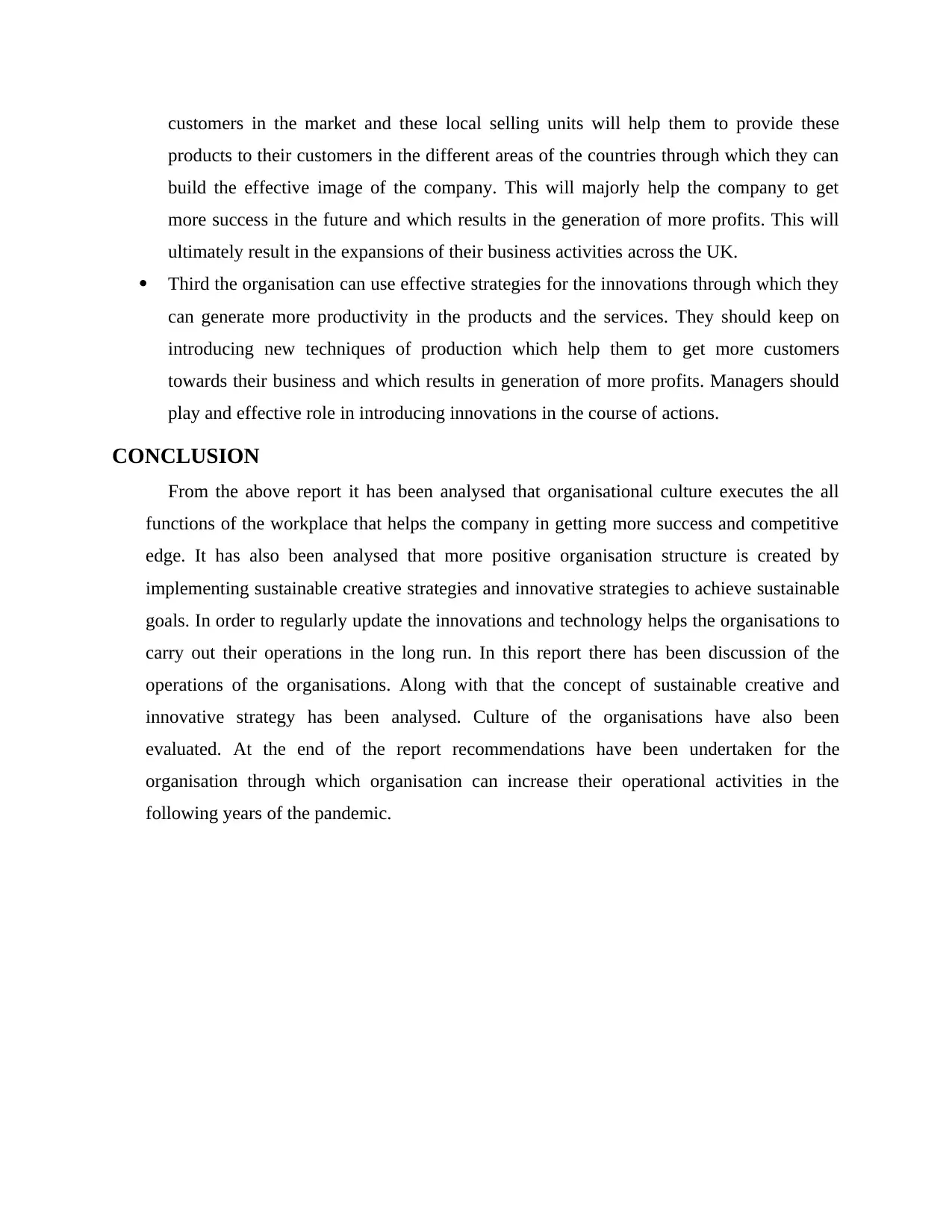
customers in the market and these local selling units will help them to provide these
products to their customers in the different areas of the countries through which they can
build the effective image of the company. This will majorly help the company to get
more success in the future and which results in the generation of more profits. This will
ultimately result in the expansions of their business activities across the UK.
Third the organisation can use effective strategies for the innovations through which they
can generate more productivity in the products and the services. They should keep on
introducing new techniques of production which help them to get more customers
towards their business and which results in generation of more profits. Managers should
play and effective role in introducing innovations in the course of actions.
CONCLUSION
From the above report it has been analysed that organisational culture executes the all
functions of the workplace that helps the company in getting more success and competitive
edge. It has also been analysed that more positive organisation structure is created by
implementing sustainable creative strategies and innovative strategies to achieve sustainable
goals. In order to regularly update the innovations and technology helps the organisations to
carry out their operations in the long run. In this report there has been discussion of the
operations of the organisations. Along with that the concept of sustainable creative and
innovative strategy has been analysed. Culture of the organisations have also been
evaluated. At the end of the report recommendations have been undertaken for the
organisation through which organisation can increase their operational activities in the
following years of the pandemic.
products to their customers in the different areas of the countries through which they can
build the effective image of the company. This will majorly help the company to get
more success in the future and which results in the generation of more profits. This will
ultimately result in the expansions of their business activities across the UK.
Third the organisation can use effective strategies for the innovations through which they
can generate more productivity in the products and the services. They should keep on
introducing new techniques of production which help them to get more customers
towards their business and which results in generation of more profits. Managers should
play and effective role in introducing innovations in the course of actions.
CONCLUSION
From the above report it has been analysed that organisational culture executes the all
functions of the workplace that helps the company in getting more success and competitive
edge. It has also been analysed that more positive organisation structure is created by
implementing sustainable creative strategies and innovative strategies to achieve sustainable
goals. In order to regularly update the innovations and technology helps the organisations to
carry out their operations in the long run. In this report there has been discussion of the
operations of the organisations. Along with that the concept of sustainable creative and
innovative strategy has been analysed. Culture of the organisations have also been
evaluated. At the end of the report recommendations have been undertaken for the
organisation through which organisation can increase their operational activities in the
following years of the pandemic.
Paraphrase This Document
Need a fresh take? Get an instant paraphrase of this document with our AI Paraphraser
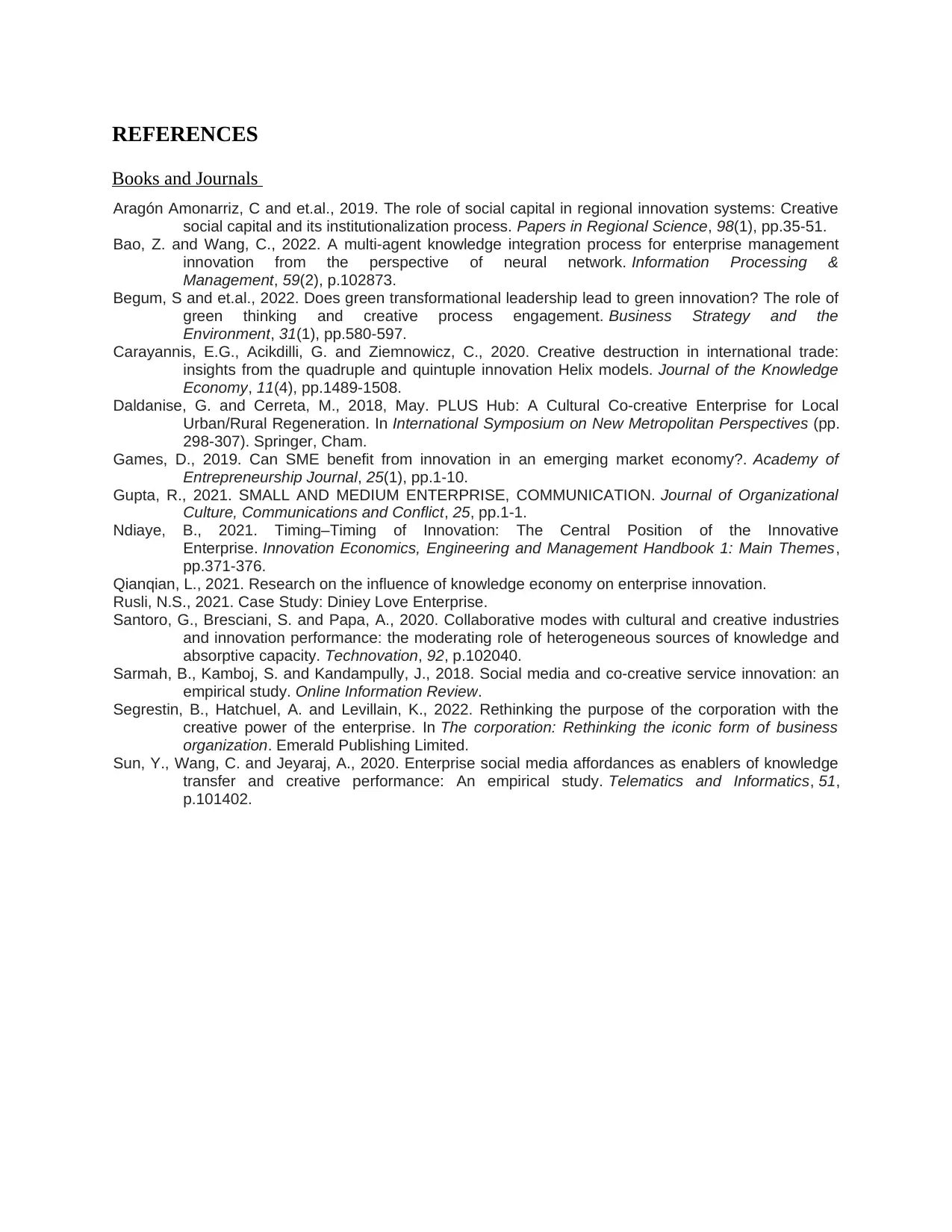
REFERENCES
Books and Journals
Aragón Amonarriz, C and et.al., 2019. The role of social capital in regional innovation systems: Creative
social capital and its institutionalization process. Papers in Regional Science, 98(1), pp.35-51.
Bao, Z. and Wang, C., 2022. A multi-agent knowledge integration process for enterprise management
innovation from the perspective of neural network. Information Processing &
Management, 59(2), p.102873.
Begum, S and et.al., 2022. Does green transformational leadership lead to green innovation? The role of
green thinking and creative process engagement. Business Strategy and the
Environment, 31(1), pp.580-597.
Carayannis, E.G., Acikdilli, G. and Ziemnowicz, C., 2020. Creative destruction in international trade:
insights from the quadruple and quintuple innovation Helix models. Journal of the Knowledge
Economy, 11(4), pp.1489-1508.
Daldanise, G. and Cerreta, M., 2018, May. PLUS Hub: A Cultural Co-creative Enterprise for Local
Urban/Rural Regeneration. In International Symposium on New Metropolitan Perspectives (pp.
298-307). Springer, Cham.
Games, D., 2019. Can SME benefit from innovation in an emerging market economy?. Academy of
Entrepreneurship Journal, 25(1), pp.1-10.
Gupta, R., 2021. SMALL AND MEDIUM ENTERPRISE, COMMUNICATION. Journal of Organizational
Culture, Communications and Conflict, 25, pp.1-1.
Ndiaye, B., 2021. Timing–Timing of Innovation: The Central Position of the Innovative
Enterprise. Innovation Economics, Engineering and Management Handbook 1: Main Themes,
pp.371-376.
Qianqian, L., 2021. Research on the influence of knowledge economy on enterprise innovation.
Rusli, N.S., 2021. Case Study: Diniey Love Enterprise.
Santoro, G., Bresciani, S. and Papa, A., 2020. Collaborative modes with cultural and creative industries
and innovation performance: the moderating role of heterogeneous sources of knowledge and
absorptive capacity. Technovation, 92, p.102040.
Sarmah, B., Kamboj, S. and Kandampully, J., 2018. Social media and co-creative service innovation: an
empirical study. Online Information Review.
Segrestin, B., Hatchuel, A. and Levillain, K., 2022. Rethinking the purpose of the corporation with the
creative power of the enterprise. In The corporation: Rethinking the iconic form of business
organization. Emerald Publishing Limited.
Sun, Y., Wang, C. and Jeyaraj, A., 2020. Enterprise social media affordances as enablers of knowledge
transfer and creative performance: An empirical study. Telematics and Informatics, 51,
p.101402.
Books and Journals
Aragón Amonarriz, C and et.al., 2019. The role of social capital in regional innovation systems: Creative
social capital and its institutionalization process. Papers in Regional Science, 98(1), pp.35-51.
Bao, Z. and Wang, C., 2022. A multi-agent knowledge integration process for enterprise management
innovation from the perspective of neural network. Information Processing &
Management, 59(2), p.102873.
Begum, S and et.al., 2022. Does green transformational leadership lead to green innovation? The role of
green thinking and creative process engagement. Business Strategy and the
Environment, 31(1), pp.580-597.
Carayannis, E.G., Acikdilli, G. and Ziemnowicz, C., 2020. Creative destruction in international trade:
insights from the quadruple and quintuple innovation Helix models. Journal of the Knowledge
Economy, 11(4), pp.1489-1508.
Daldanise, G. and Cerreta, M., 2018, May. PLUS Hub: A Cultural Co-creative Enterprise for Local
Urban/Rural Regeneration. In International Symposium on New Metropolitan Perspectives (pp.
298-307). Springer, Cham.
Games, D., 2019. Can SME benefit from innovation in an emerging market economy?. Academy of
Entrepreneurship Journal, 25(1), pp.1-10.
Gupta, R., 2021. SMALL AND MEDIUM ENTERPRISE, COMMUNICATION. Journal of Organizational
Culture, Communications and Conflict, 25, pp.1-1.
Ndiaye, B., 2021. Timing–Timing of Innovation: The Central Position of the Innovative
Enterprise. Innovation Economics, Engineering and Management Handbook 1: Main Themes,
pp.371-376.
Qianqian, L., 2021. Research on the influence of knowledge economy on enterprise innovation.
Rusli, N.S., 2021. Case Study: Diniey Love Enterprise.
Santoro, G., Bresciani, S. and Papa, A., 2020. Collaborative modes with cultural and creative industries
and innovation performance: the moderating role of heterogeneous sources of knowledge and
absorptive capacity. Technovation, 92, p.102040.
Sarmah, B., Kamboj, S. and Kandampully, J., 2018. Social media and co-creative service innovation: an
empirical study. Online Information Review.
Segrestin, B., Hatchuel, A. and Levillain, K., 2022. Rethinking the purpose of the corporation with the
creative power of the enterprise. In The corporation: Rethinking the iconic form of business
organization. Emerald Publishing Limited.
Sun, Y., Wang, C. and Jeyaraj, A., 2020. Enterprise social media affordances as enablers of knowledge
transfer and creative performance: An empirical study. Telematics and Informatics, 51,
p.101402.
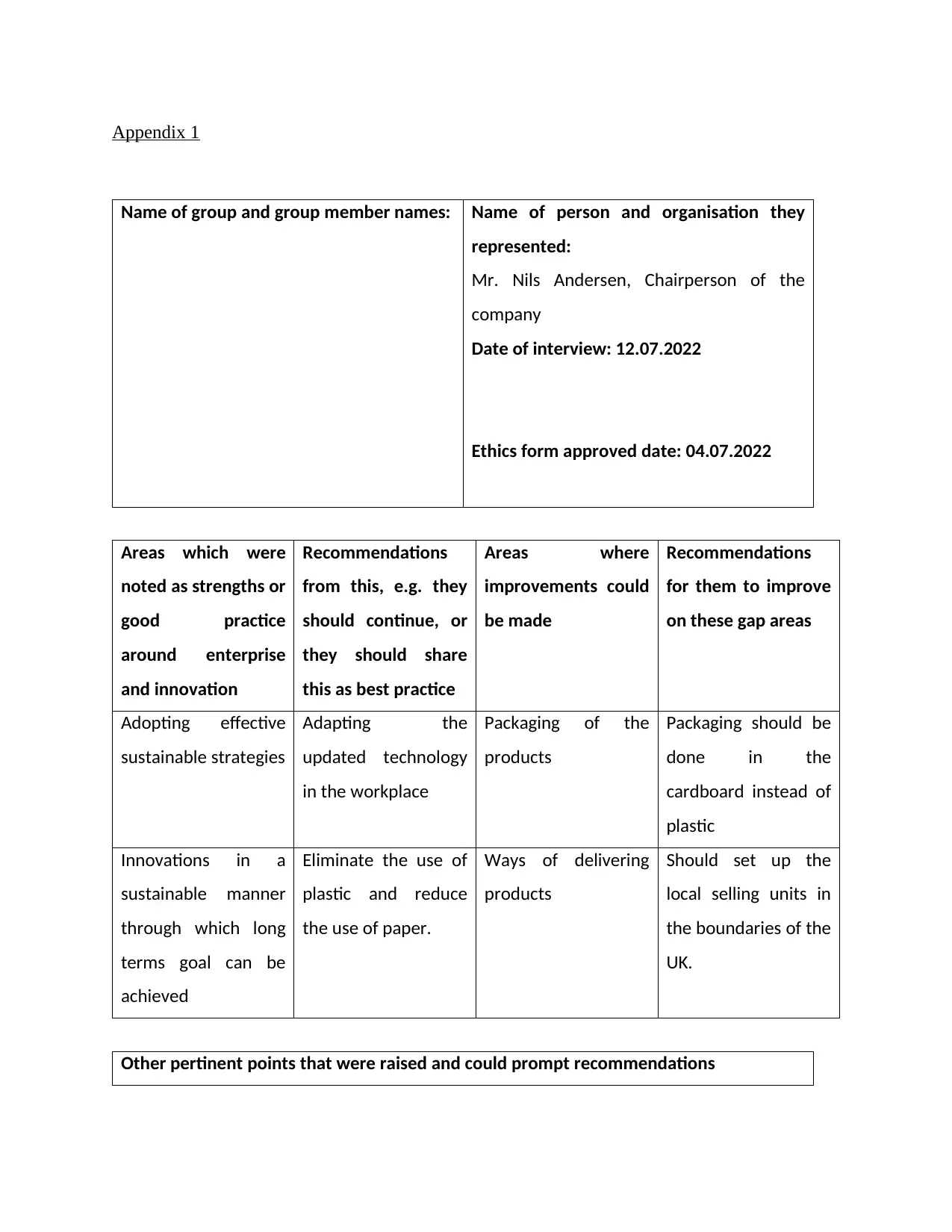
Appendix 1
Name of group and group member names: Name of person and organisation they
represented:
Mr. Nils Andersen, Chairperson of the
company
Date of interview: 12.07.2022
Ethics form approved date: 04.07.2022
Areas which were
noted as strengths or
good practice
around enterprise
and innovation
Recommendations
from this, e.g. they
should continue, or
they should share
this as best practice
Areas where
improvements could
be made
Recommendations
for them to improve
on these gap areas
Adopting effective
sustainable strategies
Adapting the
updated technology
in the workplace
Packaging of the
products
Packaging should be
done in the
cardboard instead of
plastic
Innovations in a
sustainable manner
through which long
terms goal can be
achieved
Eliminate the use of
plastic and reduce
the use of paper.
Ways of delivering
products
Should set up the
local selling units in
the boundaries of the
UK.
Other pertinent points that were raised and could prompt recommendations
Name of group and group member names: Name of person and organisation they
represented:
Mr. Nils Andersen, Chairperson of the
company
Date of interview: 12.07.2022
Ethics form approved date: 04.07.2022
Areas which were
noted as strengths or
good practice
around enterprise
and innovation
Recommendations
from this, e.g. they
should continue, or
they should share
this as best practice
Areas where
improvements could
be made
Recommendations
for them to improve
on these gap areas
Adopting effective
sustainable strategies
Adapting the
updated technology
in the workplace
Packaging of the
products
Packaging should be
done in the
cardboard instead of
plastic
Innovations in a
sustainable manner
through which long
terms goal can be
achieved
Eliminate the use of
plastic and reduce
the use of paper.
Ways of delivering
products
Should set up the
local selling units in
the boundaries of the
UK.
Other pertinent points that were raised and could prompt recommendations
⊘ This is a preview!⊘
Do you want full access?
Subscribe today to unlock all pages.

Trusted by 1+ million students worldwide
1 out of 13
Related Documents
Your All-in-One AI-Powered Toolkit for Academic Success.
+13062052269
info@desklib.com
Available 24*7 on WhatsApp / Email
![[object Object]](/_next/static/media/star-bottom.7253800d.svg)
Unlock your academic potential
Copyright © 2020–2025 A2Z Services. All Rights Reserved. Developed and managed by ZUCOL.





